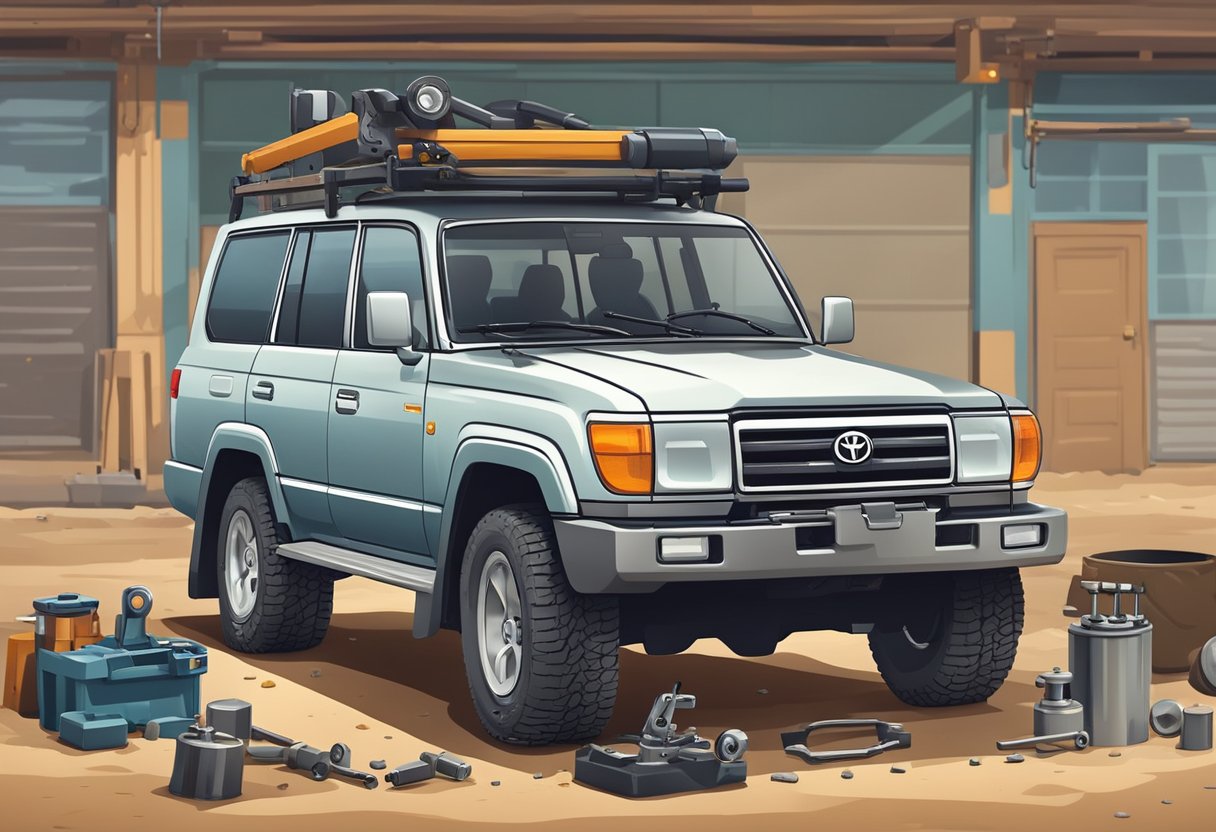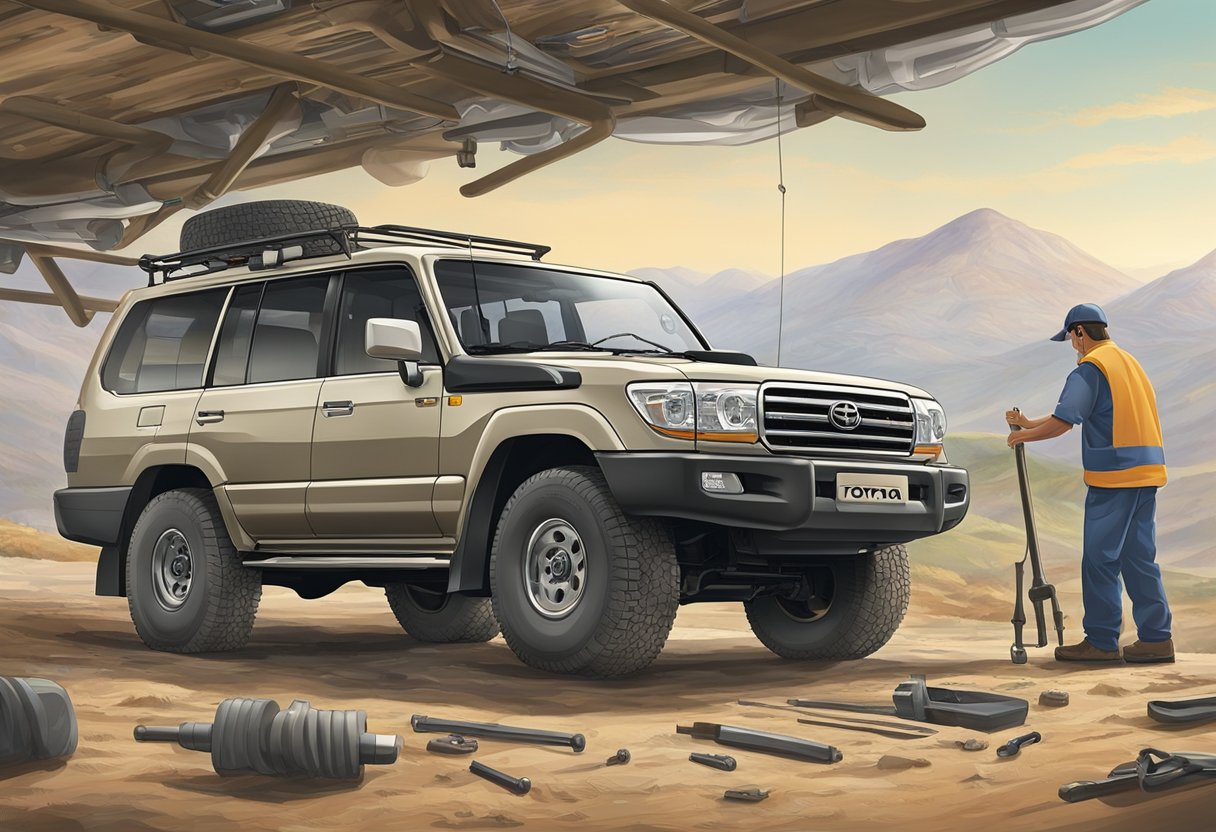*This post may contain affiliate links. As an Amazon Associate we earn from qualifying purchases.
Toyota Land Cruiser, the rough and tough road warrior, is no stranger to the occasional suspension hiccup. Imagine cruising through the wilds, your journey as smooth as butter, until suddenly it feels like you’re riding a mechanical bull. That’s a clear signal your Land Cruiser’s suspension might be calling for help. Though this beast of a vehicle is built to conquer terrains, the comfort of your ride largely hangs on the well-being of its suspension system. A worn-out suspension can turn your off-road escapades into a teeth-rattling ordeal.

Diagnosing the problem is like playing automotive detective; you’ve got to understand the clues. Does the warning light on your dash blaze like a beacon of unwanted news? Or maybe your Land Cruiser has started impersonating a lowrider on hydraulics, bouncing with a mind of its own. With a hand on your trusty toolbox and a can-do spirit, deciphering the riddles under your Toyota’s underbelly is the first step toward getting it road-ready again. And remember, while DIY might be your middle name, sometimes you just have to tip your hat and let the pros take the wheel for a suspension system overhaul.
Key Takeaways
- The Land Cruiser’s suspension is the cornerstone of off-road comfort.
- Warning lights and bouncy rides are signs to check the suspension.
- Sometimes, a professional’s touch is needed to restore the suspension.
Getting Familiar with Your Land Cruiser’s Underbelly

Before diving under your Toyota Land Cruiser, one must understand that getting up close and personal with the vehicle’s suspension is key. Whether you’re experiencing a mysterious clunking sound or your Land Cruiser seems to be mimicking a low-rider, it’s time to get acquainted with what lies beneath.
Identifying Common Suspension Issues
Detecting issues with the suspension on a Toyota Land Cruiser can often feel like you’re playing automotive detective. Here are the usual suspects that could be causing a ruckus:
- Leaking Shock Absorbers: Oil oozing out like it’s trying to escape? You’ve got a leak.
- Worn Bushings: If your ride’s as creaky as a haunted house’s floorboards, these rubber buffers might be toast.
- Mystery Noises: Unusual sounds could mean it’s time for new struts or shocks.
The AHC System and You
The Active Height Control (AHC) system in a Land Cruiser is smarter than your average bear, but even Yogi gets into trouble sometimes. When the AHC goes haywire, here are two key indicators an astute owner should watch for:
- Warning Lights: That little illuminated suspension icon isn’t trying to brighten your day; it’s telling you there’s a malfunction.
- Height Control Hijinks: If saying “rise” and “lower” feels less like commanding a vehicle and more like a fruitless attempt at levitation, your AHC may need help.
Remember, these Land Cruiser quirks are just the vehicle’s way of keeping its owner on their toes. Keep the humor, bring the tools, and your underbelly adventures will surely lead to smoother rides.
The DIY Diagnostics Guide

Before diving under their Toyota Land Cruiser with a wrench, the witty DIY mechanic knows that the key to avoiding a bumpy ride lies in understanding the symphony of sounds their chariot makes and the hieroglyphs illuminated on the dashboard.
Interpreting Clunks, Creaks, and Warning Lights
- Clunking Noise: This is the Land Cruiser’s way of saying, “Hey, look at me!” A clunk, especially when conquering the wild savannah of the mall parking lot, typically indicates a suspension component begging for attention. Whether it’s a tired shock or a cranky control arm, these sounds demand a closer look.
- Creaks: Like an old rocking chair, creaks are a sign of age but in the suspension world, that translates to wear or inadequate lubrication. The vehicle might be whispering for some grease or shouting for a replacement part.
- Warning Lights: When the Land Cruiser flashes a suspension warning light, it’s not just trying to join in on the dashboard Christmas decoration contest. That light is code for “Check me out!” and it’s best heeded before the cruiser morphs into a lowrider, albeit involuntarily.
Checking for Rust and Corrosion
- Visual Inspection: It starts with the eyes. The shrewd DIYer should look for any signs of rust or corrosion, especially in the underbelly of their beast. They should seek out the tell-tale signs of reddish-brown flaky deposits—nature’s way of adding unwanted texture to metal parts.
- Pressure Points: Poke and prod suspicious areas with a tool. If the metal gives way like a marshmallow in a campfire, that’s a strong hint that rust has been feasting away.
- Suspension Components: They should give extra scrutiny to suspension component connections, checking for corrosion that could compromise the integrity of the ride. The presence of rust here is a sly invitation to replace parts before they surrender mid-journey.
Suspension System Overhaul: When to Call in the Big Guns
https://www.youtube.com/watch?v=IJ5aotBa4JE&embed=true
When the bounce in your Toyota Land Cruiser starts feeling like a bucking bronco, it’s time to consider an overhaul of the ol’ suspenders. Deciding whether to gallop into a dealership or canter over to a specialist is a pivotal move.
Choosing a Specialist or Dealership
If one’s cruiser is veering more to the side of a derelict carnival ride than a majestic steed, considering a specialist repair shop dashes in as the first contestant. Specialists often offer a grand expertise in a less-congested arena.
- Specialist
- Pros: Tailored experience; may provide better value.
- Cons: Might need to scour the land far and wide to find the right tinkerer.
In the other corner, dealerships stand tall—like knights in shining armor they come with official seals and solemn nods.
- Dealership
- Pros: Guaranteed use of OEM parts, which imagine your old rig as fresh as a daisy.
- Cons: Premium costs—like a knight’s ransom.
Cost vs Comfort: Calculating Your Repair Bill
The eternal skirmish: one’s hard-earned coins or their royal behind’s comfort. The repair bill for a suspension revamp in a Toyota Land Cruiser is not for the faint of purse.
- Cost Considerations
- Specialist repair might slice your bill with costs that are more pleasing to the peasant’s pocket.
- Dealerships might leave one’s coin pouch lighter, but they bring peace of mind worthy of a throne.
And what of comfort?
- Comfort Considerations
- A properly restored suspension offers a ride smoother than a greased weasel.
- OEM parts—though they might pillage your pocket—promise a chariot’s return to its former glory.
To seek an estimate, one must secure an appointment; thus, allowing the court jester (the service advisor) to jest no more and provide a documented decree of the expected expenses.
Upgrades and Enhancements for Off-Roading Aficionados
https://www.youtube.com/watch?v=3SLyjGsTZ5o&embed=true
For those Toyota Land Cruiser and Lexus LX owners itching to tackle the untamed wilderness with gusto, upgrading the suspension is akin to giving your rig a set of superpowers. Here’s the lowdown on how to beef up the suspension system for both bone-jarring terrains and buttery-smooth highway cruises.
Lifting the Beast: Off-Road Suspension Customization
Toyota Prado and Land Cruiser 200 series owners—they’re a daring lot, aren’t they? They know that off-roading demands a beastly presence. Lifting these metallic chariots not only unleashes their wild side but can also provide much-needed clearance for rolling over obstacles as if they were mere pebbles. Here’s what they need to consider:
- Kinetic Dynamic Suspension System (KDSS): It might sound like something out of a sci-fi flick, but it’s actually Toyota’s way of saying, “Hey, we’ve got motion control!” This system allows for greater wheel articulation, so the Land Cruiser doesn’t flinch when the road disappears.
- Air Suspension: This isn’t your average balloon inflation kit. It offers adjustable ride height on the fly—perfect for switching between that sky-high off-road stance and a garage-friendly profile.
Keeping It Comfy: Balancing Ride Height and Comfort
It’s not all about towering over the other drivers—comfort is key, too. If drivers are going to conquer the backcountry in a Toyota Land Cruiser or Lexus LX, they’d want their steed to glide over hurdles with the grace of a gazelle on rollerblades. Balancing the rig’s altitude with a plush ride makes the journey as enjoyable as the destination.
- Ride Height: Getting this just right means they’re not scraping the stars nor spelunking the depths of the underground. It’s a perfect harmony of clearance and stability.
- Suspension Components: Upgraded shocks and springs bring a comforting embrace to the otherwise harsh ride. They’re like a bear hug for the vehicle—you know, if bears knew anything about suspension upgrades.
In essence, transforming a capable cruiser into an off-roading legend requires not just lifting its spirits (and chassis) higher but also ensuring it doesn’t shake the passengers like a martini on a bumpy trail. The Land Cruiser jauntily says, “Potholes? What potholes?” as it maintains a dignified composure regardless of the ruckus beneath it.
